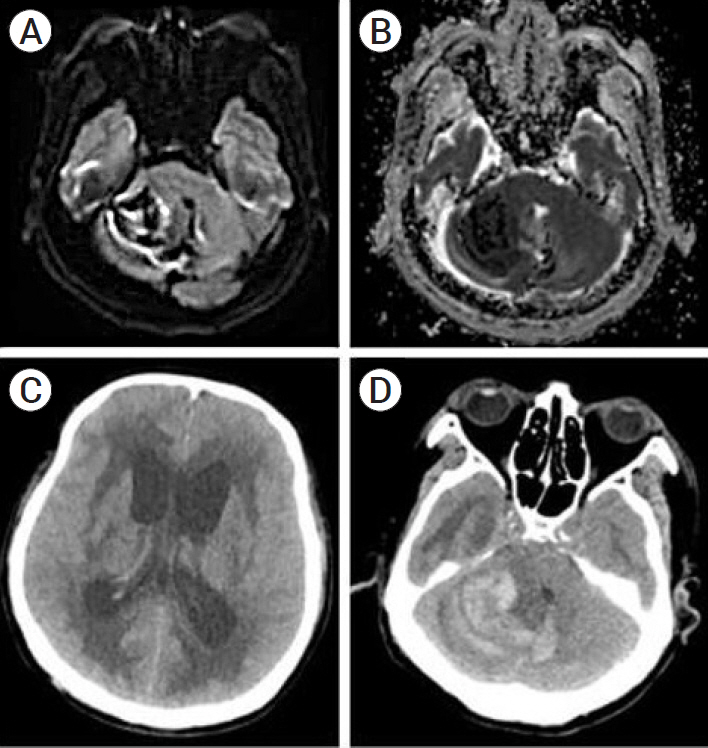J Cerebrovasc Endovasc Neurosurg.
2022 Sep;24(3):276-280. 10.7461/jcen.2022.E2021.08.005.
Remote cerebellar hemorrhage after a neurosurgical procedure: A report of three cases
- Affiliations
-
- 1Department of Neurosurgery, Seoul National University Hospital, Seoul, Korea
- 2Department of Critical Care Medicine, Seoul National University Hospital, Seoul, Korea
- 3Hospital Medicine Center, Seoul National University Hospital, Seoul, Korea
- 4Department of Thoracic and Cardiovascular Surgery, Seoul National University Hospital, Seoul, Korea
- KMID: 2533680
- DOI: http://doi.org/10.7461/jcen.2022.E2021.08.005
Abstract
- Remote cerebellar hemorrhage (RCH) is a rare complication of neurosurgical procedures and is characterized by a typical bleeding pattern defined as the “zebra sign.” Only few cases of RCH have been reported in the English literature, and its pathophysiology remains unclear. In this report, we present the cases of three patients with RCH after three different procedures: burr-hole trephination and chronic subdural hematoma evacuation of bilateral cerebral convexity with subsequent subdural drain insertion, lumbar drainage for cerebrospinal fluid divergence for thoracic endovascular aortic repair, and combined bypass surgery for moyamoya disease.
Keyword
Figure
Reference
-
1. Andrews RT, Koci TM. Cerebellar herniation and infarction as a complication of an occult postoperative lumbar dural defect. AJNR Am J Neuroradiol. 1995; Jun-Jul. 16(6):1312–5.2. Bokhari R, Baeesa S. Remote cerebellar hemorrhage due to ventriculoperitoneal shunt in an infant: A case report. J Med Case Rep. 2012; Jul. 6:222.
Article3. Brockmann MA, Groden C. Remote cerebellar hemorrhage: A review. Cerebellum. 2006; 5(1):64–8.
Article4. Hara T, Matsuda M, Watanabe S, Nakai K, Yamamoto T, Matsumura A. Remote cerebellar hemorrhage after removal of a supratentorial glioma without perioperative CSF loss: A case report. Case Rep Surg. 2013; 2013:305039.
Article5. Honegger J, Zentner J, Spreer J, Carmona H, Schulze-Bonhage A. Cerebellar hemorrhage arising postoperatively as a complication of supratentorial surgery: A retrospective study. J Neurosurg. 2002; Feb. 96(2):248–54.6. Kelley GR, Johnson PL. Sinking brain syndrome: Craniotomy can precipitate brainstem herniation in CSF hypovolemia. Neurology. 2004; Jan. 62(1):157.
Article7. Park JS, Hwang JH, Park J, Hamm IS, Park YM. Remote cerebellar hemorrhage complicated after supratentorial surgery: Retrospective study with review of articles. J Korean Neurosurg Soc. 2009; Aug. 46(2):136–43.
Article8. Schievink WI, Maya MM, Nuno M. Chronic cerebellar hemorrhage in spontaneous intracranial hypotension: Association with ventral spinal cerebrospinal fluid leaks: Clinical article. J Neurosurg Spine. 2011; Oct. 15(4):433–40.9. Sturiale CL, Rossetto M, Ermani M, Volpin F, Baro V, Milanese L, et al. Remote cerebellar hemorrhage after supratentorial procedures (part 1): A systematic review. Neurosurg Rev. 2016; Oct. 39(4):565–73.
Article10. Toczek MT, Morrell MJ, Silverberg GA, Lowe GM. Cerebellar hemorrhage complicating temporal lobectomy. Report of four cases. J Neurosurg. 1996; Oct. 85(4):718–22.
- Full Text Links
- Actions
-
Cited
- CITED
-
- Close
- Share
- Similar articles
-
- Remote Cerebellar Hemorrhage After Supratentorial Aneurysm Surgery: Report of 2 Cases
- Remote Cerebellar Hemorrhage after Supratentorial Aneurysmal Surgery: Report of Six Cases
- Remote Cerebellar Hemorrhage after Intradural Disc Surgery
- Remote Cerebral and Cerebellar Hemorrhage after Massive Cerebrospinal Fluid Leakage
- Remote Cerebellar Hemorrhage After Surgery for an Unruptured Aneurysm




